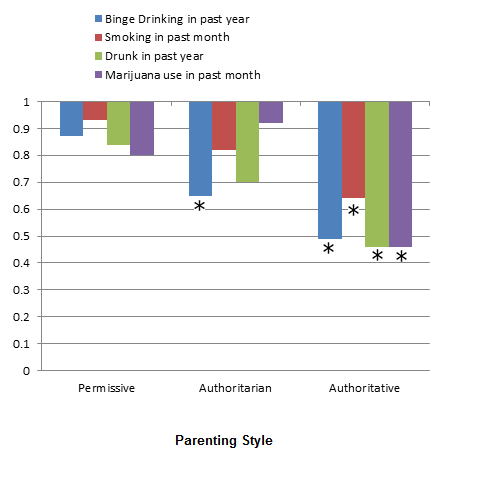STASH, Vol. 8(9) – It’s ten o’clock, do you know where your children’s friends’ parents are? Downstream effects of parenting style on adolescent substance use
Research has established that both peer groups and parenting styles shape adolescents’ substance use. Adolescents are more likely to use drugs if their friends use drugs and if their parents are relatively neglectful (Steinberg, 2001). However, few studies have examined the influence of parents of friends on adolescents’ behavior. In this week’s STASH, we review a study that examined the extent to which adolescents are influenced by their friends’ parents’ behavior (Shakya, Christakis & Fowler, 2012).
Methods
- The study used data from a longitudinal survey of adolescent health and social networks (Add Health); 90,118 adolescents across the United States were interviewed at school and at home across four waves (Harris, 2007). The study used data from the first two waves, Wave I (1994-1995) and Wave II (1996), with a total sample of 2,790 adolescents.
- Adolescents named their friends and answered questions about their parents. Using these data, the authors were able to form an index of each adolescents’ (1) mothers’ parenting styles and (2) friends’ parents’ parenting styles.
- The authors categorized parenting styles using a validated 4-cluster system:
o authoritative (high warmth, high control)
o authoritarian (low warmth, high control)
o permissive (high warmth, low control)
o neglectful (low warmth, low control)
- Adolescents reported whether they (1) had participated in binge drinking in the last year; (2) gotten drunk in the last year; (3) smoked cigarettes in the last month; and (4) used marijuana in the last month.
- The authors used generalized estimating equation procedures to account for multiple observations of the same adolescent (i.e., adolescent + friend 1, adolescent + friend 2).
Results
- As shown in Figure 1, when an adolescents’ friends’ parents used an authoritative parenting style, as compared to a neglectful parenting style, that adolescent was less likely to binge drink, smoke, drink to the point of drunkenness, and use marijuana. 1
- When an adolescents’ friends’ parents used an authoritarian parenting style, as compared to a neglectful parenting style, that adolescent was less likely to engage in binge drinking (95% CI, 6%-54%). 1

Figure. Risk ratios for association between friend’s parent’s style and adolescent risk behavior. a This is a bivariate association. *Indicates statistically significant odds ratio. Click image to enlarge.
Limitations
- The results of this study are not necessarily generalizable to the rest of non-adolescents.
- Self-report of drug use can be unreliable. The adolescents in the study may have over- or under-reported actual drug use.
- Because the results of this study are observational, they cannot fully explain the directionality of the association. Parents could be influenced by their children’s friends’ drug use to act differently.
Conclusion
The results of this study suggest that social network influences, particularly those pertaining to substance use, may extend beyond peer-peer or child-parent relationships. This study confirmed and extended previous work which found authoritative parenting to be a positive influence on adolescents, suggesting that this parenting style might influence not only parents’ own children but also their peers. More research needs to be done on the timing and directionality of this influence.
-Kat Belkin
What do you think? Please use the comment link below to provide feedback on this article.
References
Harris, Kathleen Mullan and Hedwig Lee. 2007. “The National Longitudinal Study of Adolescent Health” in International Encyclopedia of the Social Sciences, 2nd Edition, edited byWilliam A. Darity. New York, NY: Macmillan Reference.
Shakya, H.B., Christakis, N.A., & Fowler, J.H. (2012). Parental influence on substance use in adolescent social networks. Arch Pediatric Adolescent Medicine. Published online October 8, 2012. www.archpediatrics.com, doi:10.1001/archpediatrics.2012.1372
Steinberg L. (2001). We know some things: parent-adolescent relationships in retrospect and prospect. J Res Adolesc, 11(1):1-19.
________________
[1] This effect was found while controlling for the parenting style of the adolescent’s own mother, school-level fixed effects, and demographics.